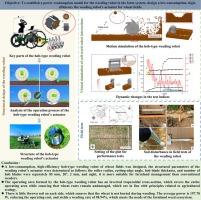用于麦田的滚刀式智能除草机:实现低功耗和高效率设计
IF 7.7
1区 农林科学
Q1 AGRICULTURE, MULTIDISCIPLINARY
引用次数: 0
摘要
智能除草机是控制农田杂草的重要工具。针对现有麦田智能除草机功耗高、除草率低、伤苗率高等问题,建立了杂草-土壤-机器相互作用过程的功耗模型,设计了一种滚刀式麦田智能除草机。设计的刀刃角度、滚筒半径、滚刀数量和滚刀厚度分别为 20°、85 毫米、8 毫米和 2 毫米。在 ProE 上建立了滚刀式智能除草机的三维(3-d)结构模型,并在离散元法环境下动态模拟了智能除草机执行器的运行过程。在此基础上,研究了作业宽度、作业深度、抛土宽度、积土厚度以及作业过程中平均功耗等性能指标的变化情况。滚刀式智能除草机的田间试验表明,作业宽度为 202.8 毫米,可覆盖麦田的行间面积;作业深度为 36 毫米,可切断或拔出麦田中大部分杂草的根;抛土宽度为 304.2 毫米,积土厚度不大于 20 毫米,远低于分蘖期小麦植株的高度。作业时的平均功率为 197.70 W,除草率为 98.93 %,伤苗率为 4.35 %。与已报道的现有除草机相比,在除草率相近的情况下,本研究开发的小麦田除草执行机构的功耗降低了约 54%。在秧苗损伤率相当的前提下,除草率提高了约 10%,显示出低功耗和高效率的显著特点。本文章由计算机程序翻译,如有差异,请以英文原文为准。

A hob-type smart weeding machine for use in wheat fields: Towards a low power consumption and high-efficiency design
Smart weeding machine is an important tool for control of farmland weeds. To solve the high power consumption, low weeding rate, and high seedling damage rate of existing smart weeding machine in wheat fields, a power consumption model was established for the weed-soil- machine interactions process and a hob-type smart weeding machine of wheat fields was designed. The cutting-edge angle, roller radius, number of hob blades, and hob blade thickness were separately 20°, 85 mm, 8, and 2 mm. A three-dimensional (3-d) structural model of the hob-type smart weeding machine was established on ProE and the operation process of the smart weeding machine’s actuator was dynamically simulated in the discrete element method environment. On this basis, changes in performance indices including the operating width, operating depth, soil-throwing width, accumulation thickness, and average power consumption during the operation were investigated. Field tests of the hob-type smart weeding machine show that the operation width is 202.8 mm, which covers the inter-row area in wheat fields; the operation depth is 36 mm, at which roots of most weeds in wheat fields can be cut or pulled out; the soil-throwing width is 304.2 mm and the accumulation thickness is not higher than 20 mm, which is much lower than the height of wheat plants in the tillering stage. The average power during operation is 197.70 W, the weeding rate is 98.93 % and the seedling damage rate is 4.35 %. Compared to existing weeding machines reported, when the weed removal rates are similar, the power consumption of the weeding actuator developed in this study for wheat fields is reduced by approximately 54 %. On the premise of a comparable seedling damage rate, the weeding rate is increased by approximately 10 %, demonstrating notable characteristics of low power consumption and high efficiency.
求助全文
通过发布文献求助,成功后即可免费获取论文全文。
去求助
来源期刊

Computers and Electronics in Agriculture
工程技术-计算机:跨学科应用
CiteScore
15.30
自引率
14.50%
发文量
800
审稿时长
62 days
期刊介绍:
Computers and Electronics in Agriculture provides international coverage of advancements in computer hardware, software, electronic instrumentation, and control systems applied to agricultural challenges. Encompassing agronomy, horticulture, forestry, aquaculture, and animal farming, the journal publishes original papers, reviews, and applications notes. It explores the use of computers and electronics in plant or animal agricultural production, covering topics like agricultural soils, water, pests, controlled environments, and waste. The scope extends to on-farm post-harvest operations and relevant technologies, including artificial intelligence, sensors, machine vision, robotics, networking, and simulation modeling. Its companion journal, Smart Agricultural Technology, continues the focus on smart applications in production agriculture.
 求助内容:
求助内容: 应助结果提醒方式:
应助结果提醒方式:


